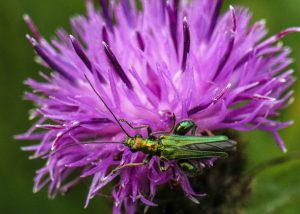
Insects, including Orthoptera
Ketton Guide and Scout Hall, Pit Lane, Ketton 9th August 2015.
Bright and sunny morning, with warmer weather forecast from mid-day. 27 members of Rutland Natural History Society assembled in the Ketton Guides and Scouts Hall, at Pit Lane, for an 11.0am start. This event was the latest in a series of workshops, to commemorate the 50 years anniversary of the Society.
Workshop title: Insects, including Orthoptera.
The first lecture was delivered by Insects recorder, Gill Chiverton. Powerpoint presentation was by David Needham.
Gill spoke on a wide range of insects, such as: The Odonata, which included the different families of Dragonflies, (Damselflies, the large Hawkers, Darters, and Broad – Bodied Chasers). Then, followed by the True Bugs, Caddis Flies, Bees, Wasps and Ants; finishing with the large and complicated lists of Beetles. The relevant species were shown on the screen. Workshops are to inform and enlighten naturalists, and open discussion and debate is encouraged from the audience. No problem here then! As the members contributed to the debate, with complex questions; also bringing their own experiences and knowledge to the table.
At 12.15pm, there was a short break for refreshments and convivial chat.
The next lecture was at 12.30pm, given by the Society’s Orthoptera Recorder, Phil Rudkin.
Powerpoint presentation by David Needham.
Orthoptera is the scientific name, given to the Grasshoppers and Crickets. At the present time, Rutland has a total of 13 species. These are made up of: 6 crickets, 2 groundhoppers, and 4 grasshoppers. The relevant salient points for each species were observed on the screen, and included the differences between grasshoppers and crickets. Various colour forms developed in the grasshoppers were noted, particularly in the Field Grasshopper and the Meadow Grasshopper.
Once again, members joined in the debate, especially the question of the lengths of the antennae
between the grasshoppers and crickets; Dr Antony Biddle gave a fascinating explanation regarding the sensory use of crickets’ antennae.
The speaker then spoke at length about the important use of the mini bat-detector, for locating the stridulations (the songs) of the species. Discussions then followed on this subject, concerning the frequencies used to hear the sounds. More debate followed on other related subjects concerning these interesting insects.
Phil Rudkin summed up the mornings lectures, stating that this is what the Rutland Natural History Society is all about; members getting together, sharing the same passion for wildlife, discussion and participation.
Thanks were expressed to David Needham for the superb Powerpoint slides. The two speakers, and all those who put up the tables and chairs, provided the refreshments, and manned the door.
At 1.45pm, everyone settled down and enjoyed their picnic lunches.
After lunch, the naturalists made their way the short distance to Ketton Quarries nature reserve. The weather was perfect (hot, sunny little cloud layer, calm and dry) for the afternoons workshop, to seek out the species that had been the subject of the lectures.
One group descended the steps down into the area of scrub, rough grasses and boulders, where orthopteran species were located, caught and identified; such as Roesel’s Bush Cricket, Long –winged Conehead, Speckled Bush Cricket and Meadow grasshopper. Bat-detectors were demonstrated and songs identified the singers.
Meanwhile, other groups entered the Cutting, and investigated the vegetation in the Valley, finding Migrant Hawker Dragonflies, various species of Bumble Bees, Harlequin and 7 Spot Ladybirds. The wildlife photographers got to work, and took digital shots of several insects, some for later identification. The event came to a finish at 4.45pm.
Later the following morning, Dr. Clive Jones summed up the proceedings in an email, as follows: “Excellent workshop, most informative, and an excellent introduction to members not so familiar with the insect orders”
Philip Rudkin 12th August 2015